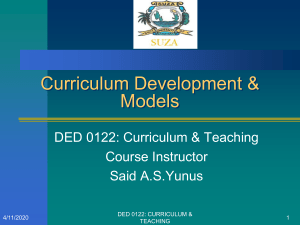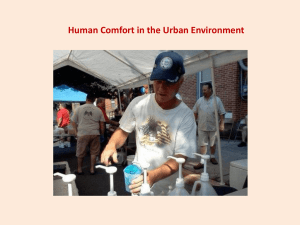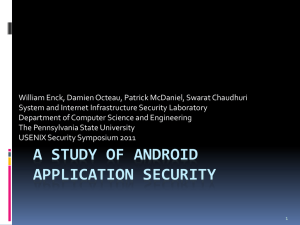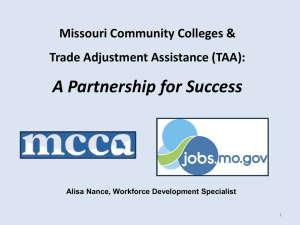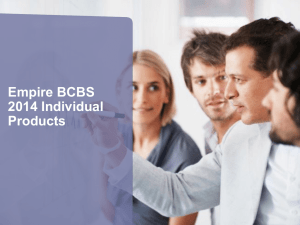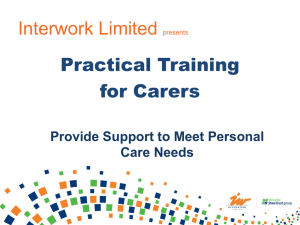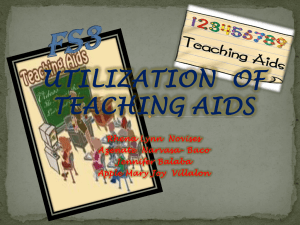Improvisation of Teaching/Learning Materials
advertisement
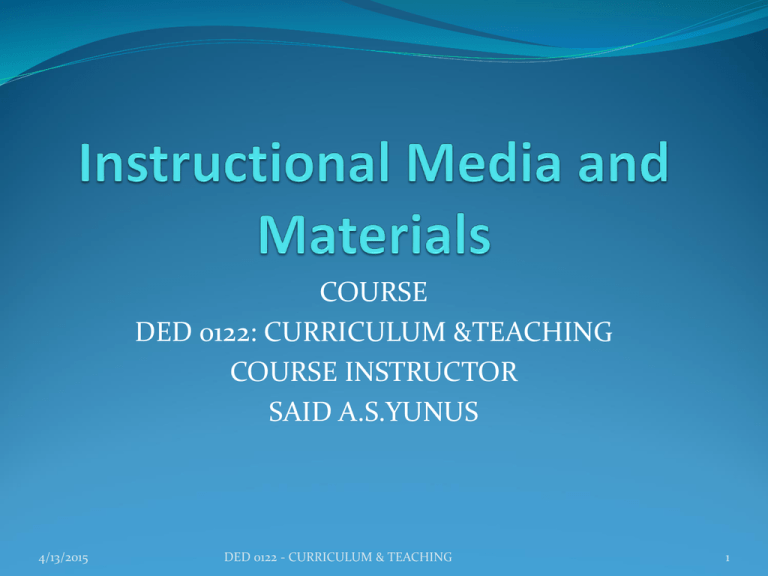
COURSE DED 0122: CURRICULUM &TEACHING COURSE INSTRUCTOR SAID A.S.YUNUS 4/13/2015 DED 0122 - CURRICULUM & TEACHING 1 4/13/2015 DED 0122 - CURRICULUM & TEACHING 2 Educational Resources Kasambira (1993) define resources as places, organisations or people in a position to provide learning experiences for students Davies (1975) point out terms used in discussing ‘resources’ as follows: Resource (s): Any items, living or inanimate used during the learning process; any actions taken deliberately to change an existing school situation 4/13/2015 DED 0122 - CURRICULUM & TEACHING 3 Educational Resources In educational context we can define resource as something such as a book, film, or picture used by teachers or students to provide information. According to John Vaizey (1968), any thing which is planned to contribute to the educational activity is a resource. It includes teachers, equipments and materials, school environment, libraries, laboratories, and other things used to promote teaching and learning process. 4/13/2015 DED 0122 - CURRICULUM & TEACHING 4 Educational Resources Walton (1975) explained that resources largely include hardware and software materials which are used in teaching and learning process, which are previously known as ‘teaching aids’. Therefore, resources in its more general sense appear to be generally inclusive of all materials by which educational message are carried out. In other words resources could be used to propagate the curriculum content between teachers and learners. 4/13/2015 DED 0122 - CURRICULUM & TEACHING 5 Hardware equipments: this group includes Duplicating machines 4/13/2015 DED 0122 - CURRICULUM & TEACHING 6 Photocopy machines 4/13/2015 DED 0122 - CURRICULUM & TEACHING 7 Video camera 4/13/2015 DED 0122 - CURRICULUM & TEACHING 8 Audio & video cassette 4/13/2015 DED 0122 - CURRICULUM & TEACHING 9 Still cameras 4/13/2015 DED 0122 - CURRICULUM & TEACHING 10 Digital cameras 4/13/2015 DED 0122 - CURRICULUM & TEACHING 11 Computer and printers 4/13/2015 DED 0122 - CURRICULUM & TEACHING 12 LCD &Overhead projector (OHP) 4/13/2015 DED 0122 - CURRICULUM & TEACHING 13 Film & Slide projectors 4/13/2015 DED 0122 - CURRICULUM & TEACHING 14 Radio& Audio cassette player 4/13/2015 DED 0122 - CURRICULUM & TEACHING 15 CD player & DVD player 4/13/2015 DED 0122 - CURRICULUM & TEACHING 16 Software materials This group includes: Printed Media- books, newspaper, pamphlets, poster, charts, etc. Visual media- illustrations, films, slides, filmstrips, videotape/cassettes, C.D ROM, flash discs, DVD realia, Microsoft programmes. Audio media- records, audiotapes/cassette, broadcasting programmes. Multi media 4/13/2015 DED 0122 - CURRICULUM & TEACHING 17 Conclusion To conclude, we can say that resources are anything within our environment planned or prepared to facilitate teaching and learning process. These resources could be abacus, bottle tops, plants, laboratory apparatus, models, charts and the like. 4/13/2015 DED 0122 - CURRICULUM & TEACHING 18 TYPES OF TEACHING & LEARNING RESOURCES 4/13/2015 DED 0122 - CURRICULUM & TEACHING 19 ADDITIVE RESOURCES These resources could be used by the teacher to extend the range of experiences. They offer no participation or involvement by the learners, hence the learners became passive. These type of resources are audio materials. E.g. tape recorders, audio CD-ROM and radio. If they are not available the lesson could still continue. 4/13/2015 DED 0122 - CURRICULUM & TEACHING 20 INTEGRATIVE RESOURCES These integrative resources are very essential in teaching and learning process. They can be associated with maximum teacher and pupil interaction. Pupils learn by doing and become very active. If they are not available in teaching and learning process become terribly effected. 4/13/2015 DED 0122 - CURRICULUM & TEACHING 21 TYPES OF TEACHING & LEARNING MATERIALS Teaching and learning resources could be classified according to their characteristics. Thus they follow under three major groups: 1. Aural – Aids (Audio aids) 2. Visual – Aids 3. Audio-Visual aids 4/13/2015 DED 0122 - CURRICULUM & TEACHING 22 Aural-Aids (Audio Aids) This group consists of those aids which can be heard. Learners use their hearing organs (ears) to listen to the sound those aids give. These aids could be: Radio Gramophone Telephone Tape/cassette These teaching and learning materials are widely used in language laboratories. 4/13/2015 DED 0122 - CURRICULUM & TEACHING 23 VISUAL - AIDS These aids give out vision. Children or learners use their eyes to look at them in the process of learning. The teaching and learning in this group are: Books Pictures Models Real objects Still pictures and silent films 4/13/2015 DED 0122 - CURRICULUM & TEACHING 24 Audio-Visual Aids This group is the combination of audio and vision or sound and sight. These aids can be heard and seen. Students or learners see the pictures and hear the sound from the audio-visual materials. These aids could be: TV Video cinema Field trips or practical demonstration excursion 4/13/2015 DED 0122 - CURRICULUM & TEACHING 25 Visual aids like charts, models, real objects could be made audio-visual materials when the teacher uses his/her voice in teaching. The teacher make them ‘talk’. The children therefore, could see the charts and hear the sound from their teacher in his/her demonstrations. 4/13/2015 DED 0122 - CURRICULUM & TEACHING 26 Cont…. A slide or film strip could be synchronized by the sound from the tape/cassette record or CD. Thus a slide as visual materials can be changed to audio visual materials by the sound from aural aid e.g. cassette or CD. Therefore, aural aids and visual aids can be changed to audio-visual materials. 4/13/2015 DED 0122 - CURRICULUM & TEACHING 27 Quiz John Vaizey defines a resource as any thing which is planned to contribute to the educational activity. From this definition, explain briefly how the teacher can be a resource. 2. Suppose there is an idea of establishing resource centre in our teachers training college, you are given a chance to propose the resources that will be available in that centre. As a student teacher, what will be your proposal and why your proposal based on that choice? 3. Is it possible to have effective and efficient teaching and learning process without using resources? Why? 1. 4/13/2015 DED 0122 - CURRICULUM & TEACHING 28 Preparation of Teaching & Learning Materials 4/13/2015 DED 0122 - CURRICULUM & TEACHING 29 Low Cost/ non Cost Materials Teachers should not crack their heads in thinking of materials to use in making their teaching /learning aids. In fact the environment which surrounds us is very rich in materials; it is almost polluted with bits and pieces of discarded materials. These materials are of no cost or they cost very little to obtain them. 4/13/2015 DED 0122 - CURRICULUM & TEACHING 30 Low Cost/ non Cost Materials There are a lot of pieces of boards, strings, boxes of plastic materials, cardboards, tins, pieces of wire and the like. This garbage could be found in the streets, school compound, dust bins, shopping centres and other places in the environment. Teachers assisted by their pupils could collect and make different types of models, charts and other teaching/learning resources. 4/13/2015 DED 0122 - CURRICULUM & TEACHING 31 Cont… Sometimes with little expense teachers could fabricate useful teaching/learning materials that otherwise would cost a lot of money. With little money and technology know how they could improvise a clock, a glob, charts, science models and other materials. In model making the teacher can use either soaked paper (paper mache), wood or clay. 4/13/2015 DED 0122 - CURRICULUM & TEACHING 32 Cont.. Pieces of paper collected in the school compound can be soaked in water to make paper mache. Children assisted by parents/guardians can collect clay for model making. It should be noted that in the fabrication process will require a little money to sustain the teaching/learning materials. Thus the materials could be in good quality, and durable. 4/13/2015 DED 0122 - CURRICULUM & TEACHING 33 Things to Consider in Improvising Teaching/Learning Materials Before you prepare the teaching/learning materials, you need to identify and determine the teaching situation you have on the ground. However, in improvising effective teaching/learning materials appropriate to the classroom teaching activities, require skills and competences. 4/13/2015 DED 0122 - CURRICULUM & TEACHING 34 Cont.. The following aspects must be considered Level of the learners Topic you want to teach Kind of teaching/ learning aid you want to develop (e.g. model or chart) Materials needed to improvise your aid 4/13/2015 DED 0122 - CURRICULUM & TEACHING 35 The Roles of Teacher in the Process of Improvisation It is important to know that, the process of improvising materials is not solely for teachers, students can be also involved effectively in the process such as collecting things from different sources, assigning tasks for them to produces learning materials etc. Thus, in the process of improvising teaching/learning materials teachers may play different role. 4/13/2015 DED 0122 - CURRICULUM & TEACHING 36 Cont… The following are the roles can be played by teacher 1. Guide 2. Creator 3. Innovator 4. Initiator 5. Evaluator/assessor 6. Motivator 7. Facilitator 4/13/2015 DED 0122 - CURRICULUM & TEACHING 37 4/13/2015 DED 0122 - CURRICULUM & TEACHING 38
